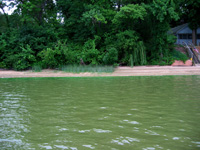Microcystis found in water samples from Severn and Magothy Rivers. |
||
| During the week of August 18th - 22nd, field biologists and citizens reported patches of blue-green algae offshore from the mouth of the Magothy River south to Thomas Point lighthouse. Subsequent water sampling revealed significant bloom concentrations (> 100,000 cells/ml) of Microcystis aeruginosa in the Severn and Magothy Rivers. Microcystis concentrations were as high as 372,995 cells/ml at the mouth of the Severn River on Tuesday August 19th, and 112,000 cells/ml at Stonington on the Magothy River on Wednesday August 20th. The greatest bloom concentrations of the year were estimated at 1.5 million cells/ml and were found in the Upper Eastern Shore on the Bush and Sassafras Rivers during late July (see HAB News from July 29, 2003: "Bush River Blue-green algal bloom continues."). People should take common precautions to reduce the risk of illness or discomfort related to blue-green algal blooms:
The distribution of bloom levels of blue-green algae has expanded farther south this year. With exceptional rain and runoff, record low salinities are being observed in the vicinity of the Bay Bridge this August. Microcystis survives best in fresh- and low-salinity water. The result of the large input of freshwater has been to provide a much larger area of available habitat for the algae in the Bay and its tributaries this summer than previous years since 1985 in the Chesapeake Bay monitoring program. The Maryland Department of Natural Resources will continue to monitor all Microcystis blooms throughout the state. For up to date information on all of Maryland's harmful algal blooms and water quality, please visit Eyes on the Bay. |

